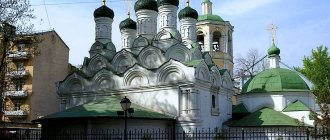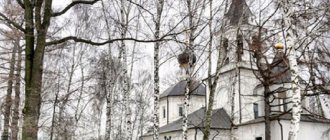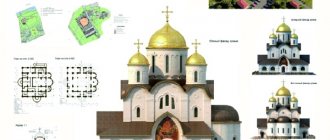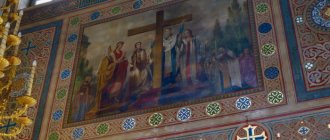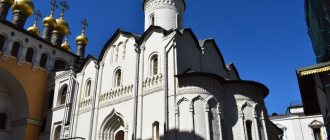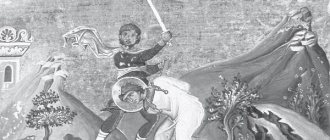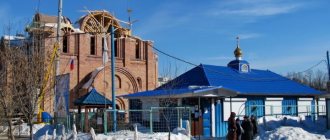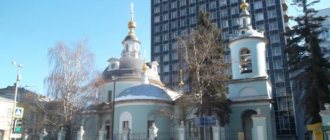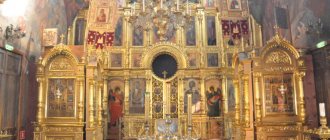Mir
Russia Moscow Church of the Dormition of the Blessed Virgin Mary in Putinki (Moscow) Map is loading…
{"format":"leaflet","minzoom":false,"maxzoom":false,"limit":50,"offset":0,"link":"all","sort":[""], "order":[],"headers":"show","mainlabel":"","intro":"","outro":"","searchlabel":"\u2026 \u0441\u043b\u0435\ u0434\u0443\u044e\u0449\u0438\u0435 \u0440\u0435\u0437\u0443\u043b\u044c\u0442\u0430\u0442\u044b","default":"","import-annotation":false,"width ":"auto","height":"350px","centre":{"text":"","title":"""link":"""lat":55.7689170000000018490027287043631076812744140625,"lon": 37.607422200000002021624823100864887237548828125,"icon":""},"title":"","label":"","icon":"","lines":[],"polygons":[],"circles":[ ],"rectangles":[],"copycoords":false,"static":false,"zoom":8,"defzoom":14,"layers":["OpenStreetMap"],"image layers":[] ,"overlays":[],"resizable":false,"fullscreen":true,"scrollwheelzoom":true,"cluster":false,"clustermaxzoom":9,"clusterzoomonclick":true,"clustermaxradius":80, "clusterspiderfy":true,"geojson":"","clicktarget":"","showtitle":true,"hidenamespace":false,"template":"","userparam":"","activeicon": "","pagelabel":false,"ajaxcoordproperty":"","ajaxquery":"","locations":[{"text":"\u003Cb\u003E\u003Ca href=\"/palomnik/%D0% A5%D1%80%D0%B0%D0%BC_%D0%A3%D1%81%D0%BF%D0%B5%D0%BD%D0%B8%D1%8F_%D0%9F%D1%80% D0%B5%D1%81%D0%B2%D1%8F%D1%82%D0%BE%D0%B9_%D0%91%D0%BE%D0%B3%D0%BE%D1%80%D0% BE%D0%B4%D0%B8%D1%86%D1%8B_%D0%B2_%D0%9F%D1%83%D1%82%D0%B8%D0%BD%D0%BA%D0%B0% D1%85_(%D0%9C%D0%BE%D1%81%D0%BA%D0%B2%D0%B0)\» title=\»\u0425\u0440\u0430\u043c \u0423\u0441\u043f\ u0435\u043d\u0438\u044f \u041f\u0440\u0435\u0441\u0432\u044f\u0442\u043e\u0439 \u0411\u043e\u0433\u043e\u0440\u043e\u0434\u0 438\u0446\u044b\u0432\u041f\ u0443\u0442\u0438\u043d\u043a\u0430\u0445 (\u041c\u043e\u0441\u043a\u0432\u0430)\»\u003E\u0425\u0440\u0430\u043c \u0423\u0441 \u043f\u0435\u043d\ u0438\u044f \u041f\u0440\u0435\u0441\u0432\u044f\u0442\u043e\u0439 \u0411\u043e\u0433\u043e\u0440\u043e\u0434\u0438\u0446\u0 44b\u0432\u041f\u0443\u0442\ u0438\u043d\u043a\u0430\u0445 (\u041c\u043e\u0441\u043a\u0432\u0430)\u003C/a\u003E\u003C/b\u003E\u003Chr /\u003E\u003Ca href=\"/palomnik /% D0%A1%D0%B2%D0%BE%D0%B9%D1%81%D1%82%D0%B2%D0%BE:%D0%90%D0%BD%D0%BD%D0%BE%D1 %82%D0%B0%D1%86%D0%B8%D1%8F\" title=\"\u0421\u0432\u043e\u0439\u0441\u0442\u0432\u043e:\u0410\u043d\u043d\u043e\ u0442\u0430\u0446\u0438\u044f\»\u003E\u0410\u043d\u043d\u043e\u0442\u0430\u0446\u0438\u044f\u003C/a\u003E: »'\u0425\u0440\u0 430\u043c\u0423 \u0441\u043f\u0435\u043d\u0438\u044f \u041f\u0440\u0435\u0441\u0432\u044f\u0442\u043e\u0439 \u0411\u043e\u0433\u043e\u0440\ u043e\u0434\u0438\u0446\u044b '' 3d\u044b\u0439\u0445\u0440 \u0430\u043c, \u043f\u0440\u0438\u043d\u0430\u0434\u043b\u0435\u0436\u0430\u0449\u0438\u0439 \u043a \u0418\u0432\u0435\u044 0\u0441\u043a\u043e\u043c\ u0443\u0431\u043b\u0430\u0433\u043e\u0447\u0438\u043d\u0438\u044e\u041c\u043e\u0441\u043a\u043e\u0432\u0441\u043a\u043e\u0 439\u0433\u043e\u0440\u043e\ u0434\u0441\u043a\u043e\u0439 \u0435\u043f\u0430\u0440\u0445\u0438\u0438 \u0420\u0443\u0441\u0441\u043a\u043e\u0439 \u041f\u 0440\u0430\u0432\u043e\u0441\ u043b\u0430\u0432\u043d\u043e\u0439 \u0426\u0435\u0440\u043a\u0432\u0438.","title":"\u0425\u0440\u0430\u043c \u0423\u0441\u043f\u 0435\u043d\ u0438\u044f \u041f\u0440\u0435\u0441\u0432\u044f\u0442\u043e\u0439 \u0411\u043e\u0433\u043e\u0440\u043e\u0434\u0438\u0446\u0 44b\u0432\u041f\u0443\u0442\ u0438\u043d\u043a\u0430\u0445 (\u041c\u043e\u0441\u043a\u0432\u0430)","link":"","lat":55.7689170000000018490027287043631076812744140 625,"lon":37.607422200000002021624823100864887237548828125,"icon":"" }],"imageLayers":[]}
55.768917; 37.607332
Russia, Moscow, Uspensky lane, 4с5
Moscow
Russia
Telephone:
(495) 699-99-93
Church of the Assumption of the Blessed Virgin Mary in Putinki
- an Orthodox church belonging to the Iveron deanery of the Moscow city diocese of the Russian Orthodox Church. Another name is the Church of the Assumption of the Blessed Virgin Mary on Malaya Dmitrovka.
History[edit]
The outlying settlement of Putinki was located in Moscow behind the Tverskaya Gate of the White City (on the site of present-day Pushkinskaya Square and Strastnoy Boulevard). The first mention of this area dates back to the 14th century. Then the suburban “Great Meadows” stretched there, where two wide roads to Tver and Dmitrov began. According to legend, here (approximately on the territory of the garden of the 24th City Hospital) in the 16th century there was one of the country palaces of Vasily III, later turned into the Travel Palace, where foreign ambassadors stayed in the 16th–17th centuries. And the name “Putinki” is believed to come from the word “path”. You had to enter the Putevoy Dvor using putinka routes, that is, crooked streets and alleys. The first mention of the temple in chronicles dates back to 1621. At first it was made of wood and was called “Uspeniya, which is in the old Ambassadorial yard” and “on Dmitrovka outside the city.” Already in those years it was famous for its myrrh-streaming icon of the Assumption of the Virgin Mary.
In the second half of the 17th century, the wooden church was probably dismantled or burned down. And in 1676, under Tsar Alexei Mikhailovich, a stone one was built on the site of a wooden church. In 1690, the first mention was made of a building on the northern side of the aisle in Moscow Baroque forms - a low octagon on a quadrangle, covered with a closed vault and topped with a faceted dome on a light drum. The chapel was consecrated in the name of St. Nicholas the Wonderworker (now the chapel of St. Sergius of Radonezh); The dome in the shape of an apple was of a rare shape - in Moscow there was such a dome only on the Church of St. Ermolaya.
In the second quarter of the 18th century, the bell tower was erected. The lane on which it stands is also named after the Assumption Church (previously - Proezzhy Lane). At the end of the 18th century, the construction of the church property was formed. In the church graveyard there were possessions: a priest, a deacon, a sexton and a malt pan.
In 1898, with the money of an unknown benefactor (6,000 rubles), the iconostasis was again gilded, the icons were restored, and the walls of the temple were decorated with paintings.
From 1906 to 1918, the rector of the Church of the Assumption was Fr. Sinkovsky Sergey Ivanovich. Since 1918, the rector is Fr. John Rozhdestvensky. Sergius Lebedev served as deacon under both abbots. In 1922, the temple was closed, looted and partially destroyed, and “34 spools of gold, 6 pounds 5 pounds of silver and 1 precious item” were confiscated. Five chapters and the top of the bell tower were broken, the passage in it was blocked, the apses were destroyed, in place of which windows and a door were broken. After its closure and desecration, the temple building was used for many years as a residential building. Private letters from the Soviet period with the return address: Uspensky Lane, building 4 have been preserved.
Gradually, the building was surrounded by extensions that completely distorted the once voluminous composition of the temple, while the territory of the church property was significantly reduced. The northwestern part of the property was torn away, and a three-story building was built on it in 1927, where the Embassy of the People's Republic of Benin is currently located. In the second half of the 20th century, the residents were resettled, and the temple housed the sewing workshop of the All-Union House of Models, which sewed, in particular, products from the Soviet couturier Vyacheslav Zaitsev. In 1990, the sewing workshop was replaced by a pattern shop. When the building of the Assumption Church was returned to the Church, the “abomination of desolation” reigned here.
The beginning of a new history of the temple. Archpriest Gleb Afanasyev was appointed the first rector. The activities of the beloved and revered priest became a solid basis for the restoration of the temple and parish life. Throughout the years, the faithful assistant to the rector of the church was his wife, Mother Lyudmila.
From the first days of his ministry, Father Gleb began caring for city hospital No. 24, where he found mutual understanding and support from the hospital management in the person of the deputy. chief physician Vladimir Nikolaevich Annenkov, who visited our temple. In the hospital, prayers were regularly held for the sick, sermons were read and conversations were held: small libraries with spiritual literature, so necessary for people going to God, were created in the wards. All this work was continued by Fr. Alexy. Patients are accustomed to meetings with a priest, they wait and prepare.
July 26, 1995 Fr. Gleb, after a serious heart disease, went to the Lord. On the fortieth day of his death, crosses were raised on the five-domed church, and this event was broadcast on television. The external restoration was largely completed, but work on restoring the interior of the temple continued. By this time, the bodies of the iconostases were created and carvings were made.
After Fr. Gleb Afanasyev was appointed rector of Fr. Maxim Mirov, who served in Putinki for about two and a half years. Currently Fr. Maxim serves in the church in honor of the Placement of the Robe of the Lord on Donskaya.
On September 15, 1998, Fr. began serving. Alexy Gomonov. The first service of the new priest took place on the Feast of the Exaltation of the Cross on September 27. Under the tireless care of Fr. Alexia's parish life acquired new content. City Hospital No. 24 became the object of the rector’s constant care, where a weekly prayer service for health is held. The priest also takes care of the Orthodox gymnasium “Peresvet”, where he teaches the Law of God. On great holidays, children and teachers receive communion in our church.
An important feature of the temple, gratifying for all parishioners, were regular prayer services: the Dormition of the Blessed Virgin Mary, the Tikhvin Icon of the Mother of God, St. Nicholas the Wonderworker, martyr. Panteleimon the healer, St. Luke of Crimea (Voino-Yasenetsky), St. blgvv. knn. Peter and Fevronia, St. To the Royal Passion-Bearers, St. Peter Mogila.
Unequal marriage
According to urban legend, the wedding of a decrepit old man and a young girl took place in the Assumption Church, which served as the prototype for the artist Vasily Pukirev for the plot of his famous painting “Unequal Marriage.” However, who exactly served as the prototypes for the characters is unknown; there are different versions on this matter.
The painting was painted in 1862. It depicts a wedding ceremony in the Orthodox Church: the groom is depicted as an old man in an expensive suit, with a condescending and slightly irritated expression on his face, while the bride is almost a child, with tear-stained eyes and a weak-willed expression on her face.
In the mid-19th century, the issue of unequal marriages and the powerless position of women married against their will became quite acute in Russia, and the painting made a great impression on the artist’s contemporaries. Its topical plot and bright, atmospheric execution propelled Pukirev to one of the most prominent places among Russian painters.
Parish life[edit]
Compound in Alyaukhovo[edit]
The Church of the Holy Royal Passion-Bearers in Alyaukhovo is assigned to the Church of the Assumption of the Mother of God in Putinki.
Address:
Moscow region, Odintsovo district, village Alyaukhovo, house 33
Peter and Fevronia Youth Club[edit]
The club in the name of Saints Peter and Fevronia is one of the largest Orthodox youth organizations in Moscow. The total number of young people involved in participation is about 4 thousand people. The main age of Club participants is 20-45 years. Since the creation of the Club (September 2007), more than 100 married couples have formed from the participants. The head of the Club is Ekaterina Gromova.
Every Sunday, with the exception of Lent and patronal feasts, at 17.00 a prayer service is served before the miraculous icon of Saints Peter and Fevronia in the Church of the Assumption (Uspensky Lane, 4), tea drinking and concerts of Orthodox performers are held. After tea, master classes on historical ballroom dancing. About 250 people come to each meeting, about 350 in the summer.
Interior decoration
Temperance Society in the Name of Saint Righteous John of Kronstadt[edit]
The Temperance Society in the name of the holy righteous John of Kronstadt was created on the initiative of the rector of our church, Archpriest Alexy Gomonov, in the last week of Lent in 2013. With this fast, many suffering from the disease of drunkenness, with the blessing of their confessor, went through a serious stage of abstinence, and our priest decided to consolidate these results by creating a Temperance Society. “Good people are dying from vodka and drugs. Not only non-believers, but also believers. And to help them, you need to make an effort. A simple confession is not enough; we must create a special environment for healing them and communicating with them,” Fr. Alexy tasks of the newly created society.
Help service for myrrh-bearing women[edit]
The charitable service of the Myrrh-Bearing Women arose in the late 90s at the Moscow Church of the Dormition of the Blessed Virgin Mary in Putinki. Its founder, Lyudmila Afanasyeva, is the widow of the first rector of this church, Archpriest Gleb Afanasyev. By decree of His Holiness Patriarch Alexy, she was appointed head of the church, head of the parish council. After the death of her husband, she concentrated all her energy on restoring the temple. The temple was restored, and a strong, friendly parish began to take shape. Then the idea arose about helping those who are so often forgotten by everyone - widowed mothers and elderly clergy.
Sunday school[edit]
Club "Verbochka"[edit]
The club of Orthodox large families “Verbochka” at the Church of the Dormition of the Mother of God in Putinki, which is a collective member of the All-Russian public organization “Many children is good!”, aims to support and unite families with children in which:
- believe that the main upbringing of children and the development of their personality occurs within the family circle;
— honor our Russian Orthodox traditions, rituals, holidays;
— they love our beautiful Russian land and its ancient capital Moscow;
— it is customary to raise children using examples of Russian history, Russian classical and patristic literature, and the best examples of foreign culture.
For joint recreation of parents and children, a summer family Orthodox camp has been created in the city of Plyos, Ivanovo region for 50 people (in 2015 - from July 10 to 25), where children and their parents can not only relax, but also take part in literary and musical evenings, folk festivals, at a charity fair, in helping the church and children of the local children's rehabilitation center and in many other joint activities.
In addition, children and parents of our family club can participate in various hobby groups.
All members of the Verbochka family club believe that only in a large family, based on strong traditions and the Orthodox way of life, can a child grow up to be a worthy citizen of our Motherland, which has always been called Holy Russia.
More detailed information about our meetings can be found on the Verbochka club website.
Head of the Club of Large Orthodox Families “Verbochka” - Kozlova Elena Vladimirovna (mother of 4 children and grandmother of the 1st granddaughter) - 8 963 7700627.
How to get there by public transport
The Church of the Assumption of the Blessed Virgin Mary in Putinki is within walking distance from the following metro stations:
- Pushkinskaya (lilac branch);
- Chekhovskaya (gray line);
- Tverskaya (green line).
From the Pushkinskaya metro station you need to turn left and walk to Malaya Dmitrovka. At the crossing, go to the opposite side of the street and turn left. Having reached the intersection of the street with Uspensky Lane, they turn right and after 100 meters a small white church building appears in front of the pilgrim.
Pilgrim[edit]
Schedule of services:
On weekdays (according to the schedule) and Saturdays: at 7:30 – Matins. Liturgy.
On Sundays: at 8:30 – Clock. Liturgy.
On the eve of Sundays, twelve days and great holidays: at 17:00 - All-Night Vigil.
Prayers with akathist: at 17:00 Tuesday (alternating): St. Peter the Mogila, the “Passionate” icon of BM, the “Constantinople” icon of BM, Sts. To the Royal Passion-Bearers. Wednesday (alternatingly): Dormition BM, “Tikhvin” icon BM, St. Sergius of Radonezh, St. Alexy, man of God. Friday: St. Luke. Sunday: blgvv. Peter and Fevronia.
Current schedule of services
Architect and exterior decoration of the temple
The Church of the Assumption of the Blessed Virgin Mary in Putinki was built according to the design of an author unknown today. This is due to the loss of the church archive during Soviet times, which is now being gradually restored thanks to the efforts of enthusiasts.
Three architectural styles are distinguished in the external decoration of the temple:
- Russian architecture of the 17th century;
- Moscow Baroque;
- early classicism.
Interesting facts about the temple
The Assumption Church in Putinki is a place of attraction for people of creative professions.
Some of them became his generous benefactors. Peretz Boris Grebenshchikov presented the church with an icon of St. George the Victorious and an image of St. Nicholas the Wonderworker. The musician and collector of ancient icons donated the temple image of the “Assumption of the Blessed Virgin Mary,” the icon of the “Holy Trinity” and many other ancient images.
There are many more interesting facts about the temple:
Father Gleb Afanasyev asked to give him some empty church to restore, being a seriously ill man. The building on Uspensky Lane was heavily damaged and littered. For several years, the abbot and a small group of assistants cleaned the interior and surrounding area.
Only after some time did the restoration of the temple come to the attention of the capital’s authorities. The community acquired generous sponsors and helpers , whose assistance made it possible to complete the reconstruction in a short time.
Construction materials, special equipment and builders were provided by enterprises and government services (Promstroy, Moscow Department of Capital Repairs, Service Department of the Ministry of Foreign Affairs of the Russian Federation). The lighting fixtures were donated by the Sudoimport enterprise, which was located next to the temple under construction.
Description of the architecture of the temple and its brief history:
Under the tutelage of the Assumption Parish is the first Orthodox school “Peresvet”, whose students not only study the Holy Scriptures, but also learn to live according to Orthodox traditions. They pray before classes begin and attend prayer services in the Assumption Church, studying regular school subjects in the light of the Orthodox faith.
The successful experience of the association of myrrh-bearing wives prompted the organization on its basis of a special patriarchal commission, which deals with issues of assistance to retired priests and their widows. Social service in the form of coordinating her work was continued by Lyudmila Vladimirovna Afanasyeva.
From the very beginning of the revival of spiritual life, Sunday school classes have been held on the basis of the temple.
Trips to children's Orthodox camps were organized for her students. The paintings of the main temple were partially preserved under layers of paint and dirt. The restoration team managed to preserve and update the surviving fragments. Then, based on them, all their other parts were recreated.
In 2008, the construction of the Church of the Holy Royal Passion-Bearers in the Zvenigorod region was completed. The Assumption Community plans to support the restoration of the Passion Monastery, located before 1937 on Pushkinskaya Square.
The history of the origin of the Orthodox parish magazine, which appeared in 2003 in the form of a photocopied four-page leaflet, is interesting. Gradually, the church printed publication was transformed, expanding the topics of publications and increasing the volume.
The quality of the magazine improved, and by 2008 it had become a large church-wide almanac, 100 pages long.
Feast of the Dormition of the Mother of God
According to Church Tradition, the Mother of Christ died in the middle of the 1st century AD. in Jerusalem. It was revealed to her in advance from above that death was imminent. The disciples of Christ, who preached His teachings far beyond the borders of Israel, also learned about this. They returned to their native lands to say goodbye to the Mother of God and solemnly bury Her.
One of the apostles, Thomas, was able to arrive in Jerusalem only a few days after the death of the Most Pure One. Saddened by the delay, he asked to open the cave-tomb of Mary in order to say goodbye to at least Her body. However, the grave turned out to be empty, only the fragrant robes of the Mother of God lay inside. On the same day, surrounded by angels, She appeared to the disciples of Christ with the words “Rejoice! For I am with you always."
The Orthodox Church teaches that the Lord resurrected His Mother and took Her and her body to heaven. Therefore, the Assumption is revered as the great holiday of the reunion of the Virgin Mary with the Son, Her transition from temporary earthly service to eternal Heavenly service. Let us quote the words of Saint Ignatius Brianchaninov:
“On the third day, after Her blessed Dormition, the Mother of God rose from the dead and now lives in heaven, soul and body. She not only lives in heaven, She reigns in heaven... She has been given special power and special boldness to intercede before God on behalf of humanity.”
So, after Her Dormition, the Virgin Mary became the Heavenly Lady, Prayer Book and Intercessor of the entire Christian race. This means that she became the Patroness of those peoples who adopted Christianity much later than the Savior’s earthly life. This was extremely important for the inhabitants of Ancient Rus', which was baptized at the end of the first millennium. Therefore, the Feast of the Assumption was especially revered by our ancestors. Most ancient Russian churches were dedicated to him. Let's talk about the two most significant of them.
Prayers to the Most Holy Theotokos in honor of the Feast of Her Assumption
Troparion, tone 1
At Christmas you preserved your virginity, / in the Dormition you did not abandon the world, O Mother of God, / you reposed in the life, Mother of the Life of the Life, / and through your prayers you delivered our souls from death.
Translation: At the birth of Christ, You preserved your virginity and did not leave the world after your death, Mother of God: You passed into life as the Mother of Life, and through Your prayers You deliver our souls from death.
Kontakion, tone 2
In prayers the never-sleeping Mother of God / and in intercessions the immutable hope / the grave and mortification cannot be restrained: / like the Mother of the Life / to the life / in the womb of the Ever-Virgin One.
Translation: In the prayers of the never-sleeping Mother of God and in the intercessions, the grave and mortality did not hold back the unshakable hope. For She, as the Mother of Life, was brought to life by the One Who dwelt in Her eternally virgin womb.
Mentors
Very little information is known about the rectors of the Assumption Church on Putinki, who headed the parish in pre-revolutionary times.
The following names are known from surviving sources:
- O. Sergei Stenkovsky (1906-1918);
- O. John Rozhdestvensky (1918).
At the head of the parish after the return of the church to the fold of the church were three priests:
- O. Gleb Afanasyev (1992-1995);
- O. Maxim Mirov (1995-1998);
- O. Alexy Gomonov (since 1998).
The widow of Fr. is actively working to develop and strengthen the parish community. Gleba mother Lyudmila Vladimirovna Afanasyeva. She is the head of the church community and heads the society of Myrrh-Bearing Women.
Architectural ensemble of the temple
The Church of the Assumption of the Blessed Virgin Mary, located in the historical district of Putinki, consists of 3 parts.
The main building, which includes a five-domed church with an adjacent apse and a refectory . The church is a pillarless, square building in plan, ending with a closed vault. The outside is decorated with two rows of keel-shaped kokoshniks, above which there are five decorative drums topped with onion-shaped heads.
They are decorated with large openwork crosses with a lower crossbar in the shape of a month. The base of each drum is decorated with a belt made of kokoshniks. Adjacent to the eastern façade is a semicircular apse covered with a cone-shaped vault. The refectory part is covered with a gable roof.
The facades of the main building are decorated with decorative half-columns and wide cornices. The drums are decorated with a belt of decorative arches.
The northern aisle, currently consecrated in the name of St. Sergius of Radonezh, is made in the Moscow Baroque style. It is a structure of a low four, on which a squat figure of eight is installed, covered with a closed vault. From the outside it looks like a helmet-shaped dome, on which is mounted a narrow drum, topped with an apple-shaped dome.
Adjacent to the eastern façade is an identical main apse.
The bell tower is the most recent part of the temple in terms of construction. It was built in the classical style typical of the 2nd half of the 18th century. It consists of two square and two octagonal tiers. The main porch is located in its lower tier. The open belfry is located in the upper octagonal tier.
The bell tower is crowned with a helmet-shaped dome, ending with a drum with an apple dome. The walls of the building are made of red brick and covered with white façade whitewash. The bell tower is covered with yellow plaster, on which white decorative elements stand out.
Interior decoration
The Church of the Assumption of the Blessed Virgin Mary in Putinki has a rich interior. The walls and vaults of the main part of the temple are covered with narrative paintings on biblical themes and ornaments of plant and geometric elements. The central three-tiered iconostasis is carved from larch and decorated with gilding and enamel decorative elements.
Openwork canopies, icon cases and lecterns for icons, which are placed around the entire perimeter of the temple, are made of wood. The Sergius chapel also has decorations from colored wall paintings telling about the life of St. Sergius of Radonezh.
The iconostasis in the chapel is decorated in the same style as the main part of the main temple.
Rules for visiting the temple
A parishioner's clothing should be modest and closed. Women wear a skirt below the knee. The top of the outfit should have a modest neckline and cover the elbows. The parishioner's head is covered with a scarf. Men, on the contrary, take off their headdress before entering the temple, and they must also wear trousers, shirts or T-shirts (without inscriptions).
You cannot enter the holy place in shorts, open T-shirts and beach shoes.
In addition, when visiting any Orthodox church, you should follow certain rules and recommendations:
- It is necessary to arrive at the service some time in advance in order to have time to submit notes, light candles and venerate the icons. It is also necessary to take a comfortable place where the person will not impede the progress of the service.
- You should prepare in advance for visiting the temple with children. You can take them to church during your free time from the service and talk about the meaning of the actions being performed by watching a video recording of the liturgy.
- During worship, you should focus on prayer and let go of all worldly thoughts and worries. You should not greet or talk to people you know.
During communion, you should not rush or push other parishioners. They await their turn to receive the holy gifts with calmness and humility.

